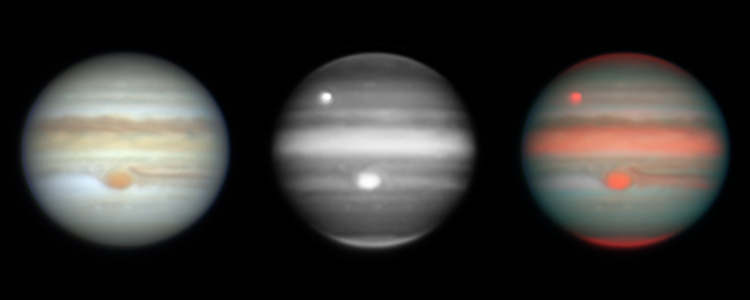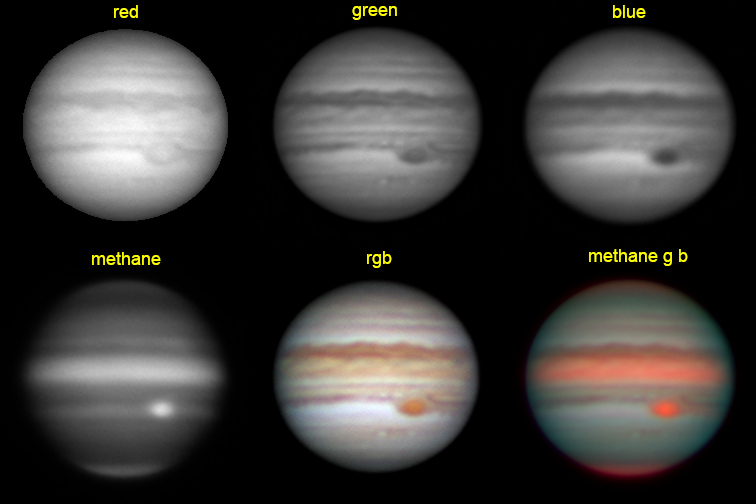in the methane filter image below, there is high signal at the great red spot (a giant storm high up in the atmosphere), at a high altitude equatorial belt, and at polar clouds. in contrast the signal is extremely low on the east and west sides where the light passes tangentially through extremely thick layers of methane:
The swirls around the GRS (center) and red trail (right) might be related to the GRS unfurling:
here's my take on methane filters. methane (CH4 for you organic chemistry fans) is present throughout the atmosphere of the gas giants in our solar system. it generally absorbs light in the red end of the spectrum. the methane filter only passess light in a very narrow range around a specific *absorption* band of methane in the infrared (no green house gas comments please). since the gas giants are full of methane, they actually appear very dark with a methane filter (in contrast, the jovian moons are extremely bright relative to jupiter with this filter as they have no methane). so when sunlight hits jupiter and reflects back to us, the light travels through less methane where high altitude clouds reflect the light back (so less light is absorbed). the higher the clouds, the brighter the signal (factor of 2 here since the signal is absorbed on the way in and out).
here's a sequence of jovian moon europa (which has no methane atmosphere) passing across the surface of jupiter. reflecting all the methane signal, europa is extremely bright in the methane images, in contrast to the dark disk where methane absorbs the light:

conversely, europa is barely detectable in the visible light images as jupiter's surface shines so brightly:

Imaging details:
 |
| Jupiter 7/21/2019 05:54 UTC RGB left, Methane center, Methane(as red)-GB right |
The swirls around the GRS (center) and red trail (right) might be related to the GRS unfurling:
 |
| Jupiter 6/29/19 06:17 UTC, Europa upper left |
 |
| Jupiter 6/27/19 05:23 UTC |
here's my take on methane filters. methane (CH4 for you organic chemistry fans) is present throughout the atmosphere of the gas giants in our solar system. it generally absorbs light in the red end of the spectrum. the methane filter only passess light in a very narrow range around a specific *absorption* band of methane in the infrared (no green house gas comments please). since the gas giants are full of methane, they actually appear very dark with a methane filter (in contrast, the jovian moons are extremely bright relative to jupiter with this filter as they have no methane). so when sunlight hits jupiter and reflects back to us, the light travels through less methane where high altitude clouds reflect the light back (so less light is absorbed). the higher the clouds, the brighter the signal (factor of 2 here since the signal is absorbed on the way in and out).
here's a sequence of jovian moon europa (which has no methane atmosphere) passing across the surface of jupiter. reflecting all the methane signal, europa is extremely bright in the methane images, in contrast to the dark disk where methane absorbs the light:

conversely, europa is barely detectable in the visible light images as jupiter's surface shines so brightly:

Imaging details:
camera ZWO ASI 290MM with ZWO RGB filters
Baader methane 889 nm 8 nm bandwidth
celestron 11" Edge HD
East Bluff, CA
East Bluff, CA
90 second captures, 2x binning for methane
no barlow
7/21/19
2 captures each filter
upsampled 2x for processing, then reduced to 60%
6/29/19
4 captures each filter, except 12 for methane
6/27/19
2 captures each filter
no barlow
7/21/19
2 captures each filter
upsampled 2x for processing, then reduced to 60%
6/29/19
4 captures each filter, except 12 for methane
6/27/19
2 captures each filter
gain 351, exposure ~0.6-1.0 ms, 30% histogram, ~280 fps
methane exposure 111-240 ms, 3-8 fps
Hi, I am interested in your methane images of Jupiter. Please contact me at (858)-922-3968 or email dbruns@stellarproducts.com
ReplyDeleteThanks,
Don Bruns
San Diego